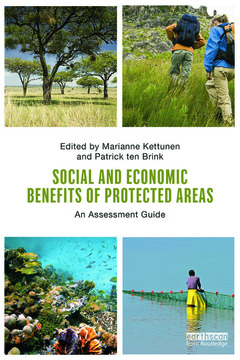Social and Economic Benefits of Protected Areas An Assessment Guide
Coordonnateurs : Kettunen Marianne, ten Brink Patrick

Protected areas (PAs) contain biodiversity and ecosystems of high conservation value. In addition, these areas provide a range of benefits, both direct and indirect, to our societies and economies, i.e. so called ecosystem services. These services include, for example, an ecosystem's ability to regulate floods and climate, purify water, secure the pollination of crops, and create opportunities for recreation, culture and tourism.
This book offers a comprehensive introduction to the socio-economic benefits of PAs and PA networks and provides step-by-step practical guidance on identifying, assessing and valuing the various ecosystem services and related benefits provided by PAs. It also aims to improve the communication of PA benefits to different stakeholders and the general public. It is shown that identifying and valuing the socio-economic benefits of PAs can be beneficial for several reasons. Demonstrating socio-economic importance of a protected site can significantly increase political and stakeholder support for the site and resolve conflicts between different interest groups. This can lead to positive changes in policies and decision-making. Insights on PA benefits are also needed to identify a combination of actions and land use practices that best support the sustainable and equitable utilisation of these benefits, while retaining a site?s conservation goals. Finally, demonstrating different benefits can help to discover alternative and sustainable sources for financing the management of PAs.
Introduction 1. Introduction, Objectives and Approach Part 1: Contextual Guidance 2. Protected Areas: Their Values and Benefits 3. General Principles for Estimating the Socio-economic Value of Benefits Provided by Protected Areas Part 2: Practical Guidance Step I. A Scoping Assessment of Possible Benefits 4. Scoping Assessment of Benefits Provided by Protected Areas Annex 1. Scoping Assessments of Benefits Provided by Protected Areas – an Example of Application 5. Deciding which Benefits to Analyse in More Detail Step II. Detailed Methodological Guidance to Estimating Benefits 6. Provisioning Services and Related Goods Annex 2. Step by Step Guidance: Valuation of Biodiversity Resources 7. Regulating Services and Related Goods Annex 3. Step by Step Guidance: Water Related Ecosystem Services Annex 4. Step by Step Guidance: Climate Change Mitigation (Carbon Storage and Sequestration) 8. Cultural Services and Related Goods Annex 5. Step by Step Guidance: Ttourism, Rrecreation and Oother Cultural Benefits 9. Appreciating the Value of Supporting Service 10. Wider Socio-economic Benefits 11. Costs Related to Protected Areas 12. Assessing Net Benefits: Site Level Annex 6. Calculating Net Present Values (NPVs) and the Effect of Different Discount Rates 13. Assessing Net Benefits: Multiple Sites Step III: Interpreting, Using and Communicating The Estimates 14. Interpreting the Results of Socio-economic Assessments 15. Using and Communicating the Results Conclusions 16. Conclusions and Way Forward
Marianne Kettunen is Senior Policy Analyst at the Institute for European Environmental Policy (IEEP) and Guest Researcher at the Finnish Environment Institute, Helsinki, Finland with dedicated experience in studies, capacity building and policy influence related to the socio-economic role of biodiversity and ecosystem services and supporting the integration of these aspects into decision-making processes.
Patrick ten Brink is Senior Fellow and Head of Office at the Institute for European Environmental Policy (IEEP) in Brussels, Belgium. He is also the editor of the book: "The Economics of Ecosystems and Biodiversity in National and International Policy Making", developed within "The Economics of Ecosystems and Biodiversity" (TEEB) project, administered by the United Nations Environment Programme.
Date de parution : 08-2013
15.6x23.4 cm
Date de parution : 08-2013
15.6x23.4 cm
Disponible chez l'éditeur (délai d'approvisionnement : 14 jours).
Prix indicatif 160,25 €
Ajouter au panierThèmes de Social and Economic Benefits of Protected Areas :
Mots-clés :
Protected areas; Economic valuation; Sociology; Natural Resource Management; Ecosystem Services; UK NEA; Te Ch; Pr Ic; Es Ta; UK National Ecosystem Assessment; Lo Ca; Si Te; CCI; Socioeconomic Assessments; Wider Socio-economic Benefits; Socio-economic Assessments; Marine Protected Areas; Human Wildlife Conflicts; Step Iii; Scoping Assessment; Socio-economic Valuation; Leuser National Park; Bio Intelligence Service; Water Related Ecosystem Services; Classic CBA; PA Management; Crop Wild Relatives; Socioeconomic Value; Madidi National Park



